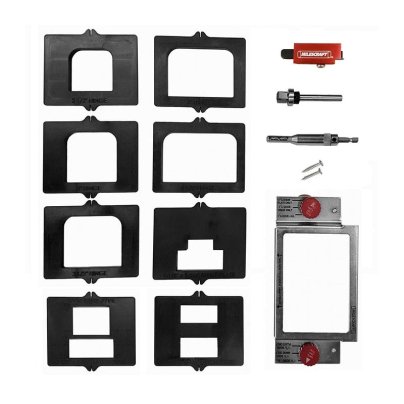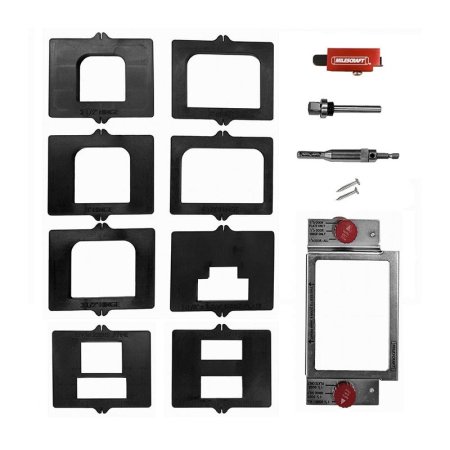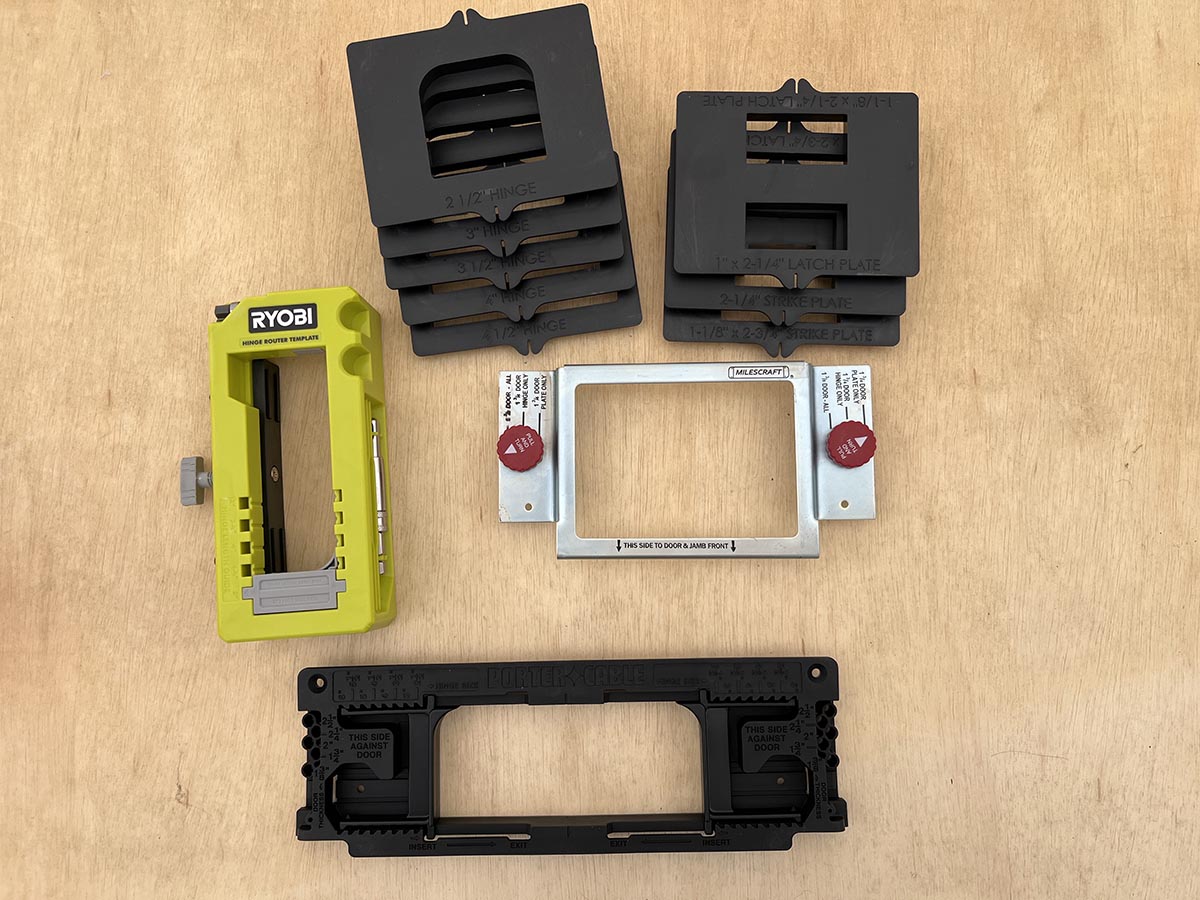
We may earn revenue from the products available on this page and participate in affiliate programs. Learn More ›
Rather than working freehand, even skilled carpenters use door hinge jigs for fast, accurate positioning of door hardware. This tool lays out the precise location of the hinge and serves as a router template for fast, easy cutouts. Most are simple enough for relatively inexperienced DIYers to use, and many are very affordable—especially when compared to the cost of ruining a door. We wanted to find the most accurate, versatile, and durable options, so we spent a day testing three of the best-rated door hinge jigs. Our favorite, the Milescraft HingeMate350, was easy to use, worked with a wide range of doors and hinge sizes, and even came with its own router bit, self-centering drill bit, and corner chisel.
As good as it is, however, the HingeMate system has a few limitations. Compared to the adjustable one-piece models we tested, its interchangeable drop-in templates take up more space when not in use. And if you’re installing cabinet door hinges, an entirely different type of jig will be required. In this guide, we’ve detailed our experience from testing, and why we consider the HingeMate system the best option for most cases. We also cover other great options that might be a better fit for more unique circumstances, including triple-hinge jigs and hidden hinge jigs for cabinetry. If you’re looking for the best door hinge jigs for all your home maintenance and remodeling needs, this is the guide for you.
Door Hinge Jigs Comparison Chart
| Hinge template sizes | Compatible door thickness | Secures with | |
| Milescraft HingeMate350 Door and Jamb Install Kit | 5 sizes from 2½ inch to 4½ inches | 1⅜ inch and 1 ¾ inch | Adjustable cams |
| Ryobi A99HT3 Door Hinge Template | 5 sizes from 3 inch to 5 inch | Up to 2 inches | Integrated clamp |
| Porter-Cable 59370 Door Hinge Template | 8 sizes from 2 ½ inch to 6 inches | 5 thicknesses from 1⅜ inches to 2½ inches | Locking pins |
| Milescraft 1229 Hinge Jig Plus | 7 sizes from 2 ½ inch to 4 ½ inch | 1 ⅜ inch and 1 ¾ inch | Integrated clamp |
| Porter-Cable 59381 Door Hinge Template Kit | 7 sizes from 3 inch to 6 inch | 1⅜ inch, ¾ inch, 2 inch, 2¼ inch, and 2½ inch | Locking pins |
| Trend AnyDoor Butt Hinge Template | Any size | Any thickness from 1 inch to 2 ½ inches | Bradawls or wood screws |
| Kreg KHI-Hinge Concealed Hinge Jig | 1 1/16 inch concealed hinge | Any thickness | Wood screws |
| Milescraft 1342 Euro Hinge Jig | 35 millimeter concealed hinge | Any thickness | Wood screws |

for Bob Vila
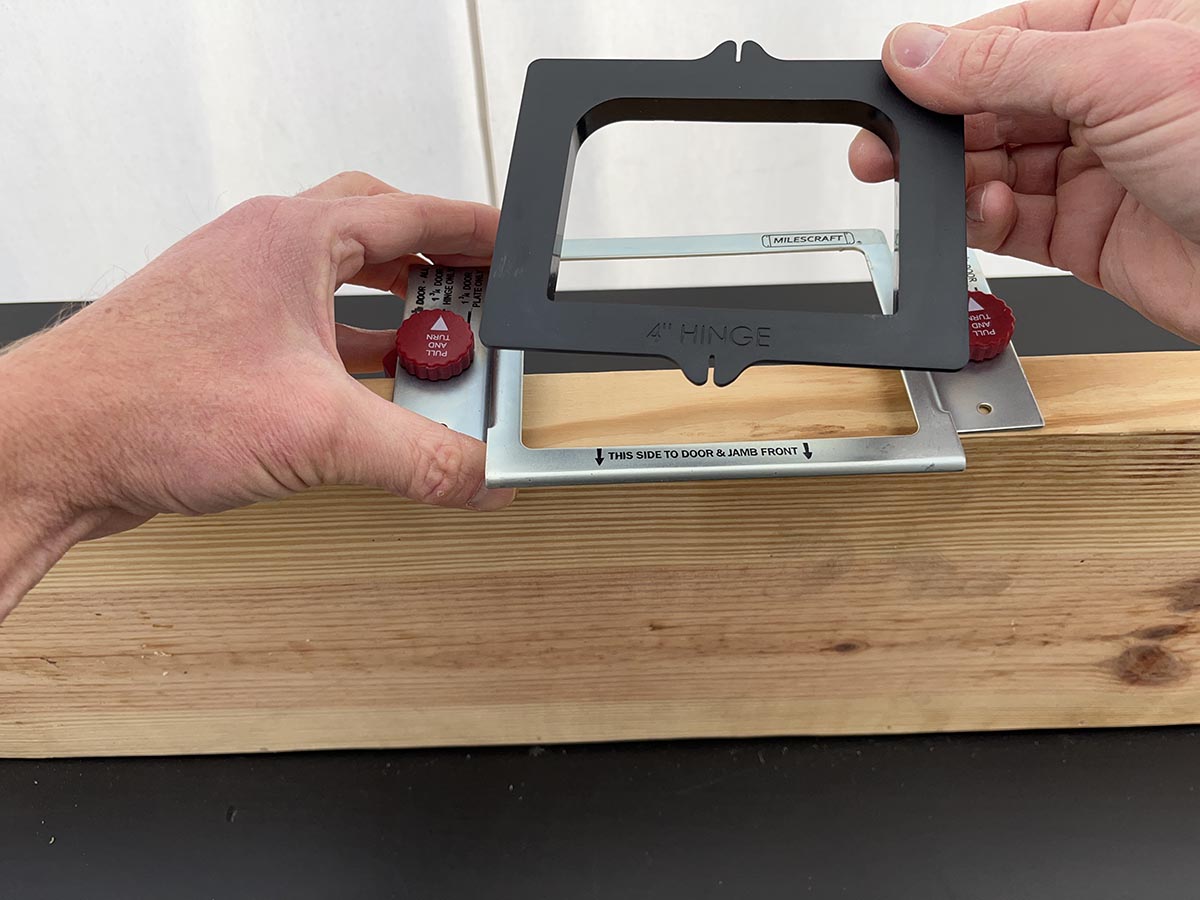
for Bob Vila
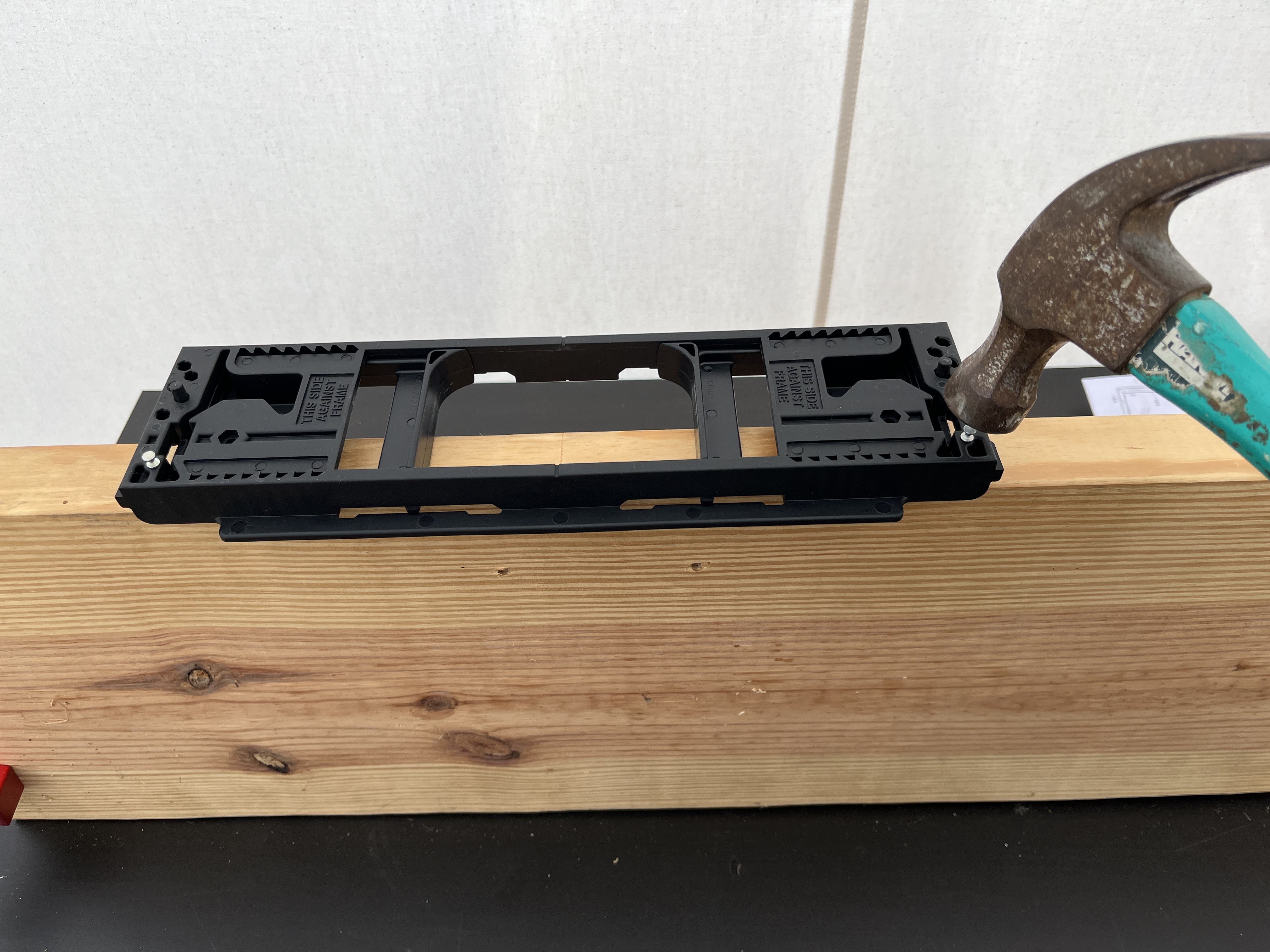
for Bob Vila
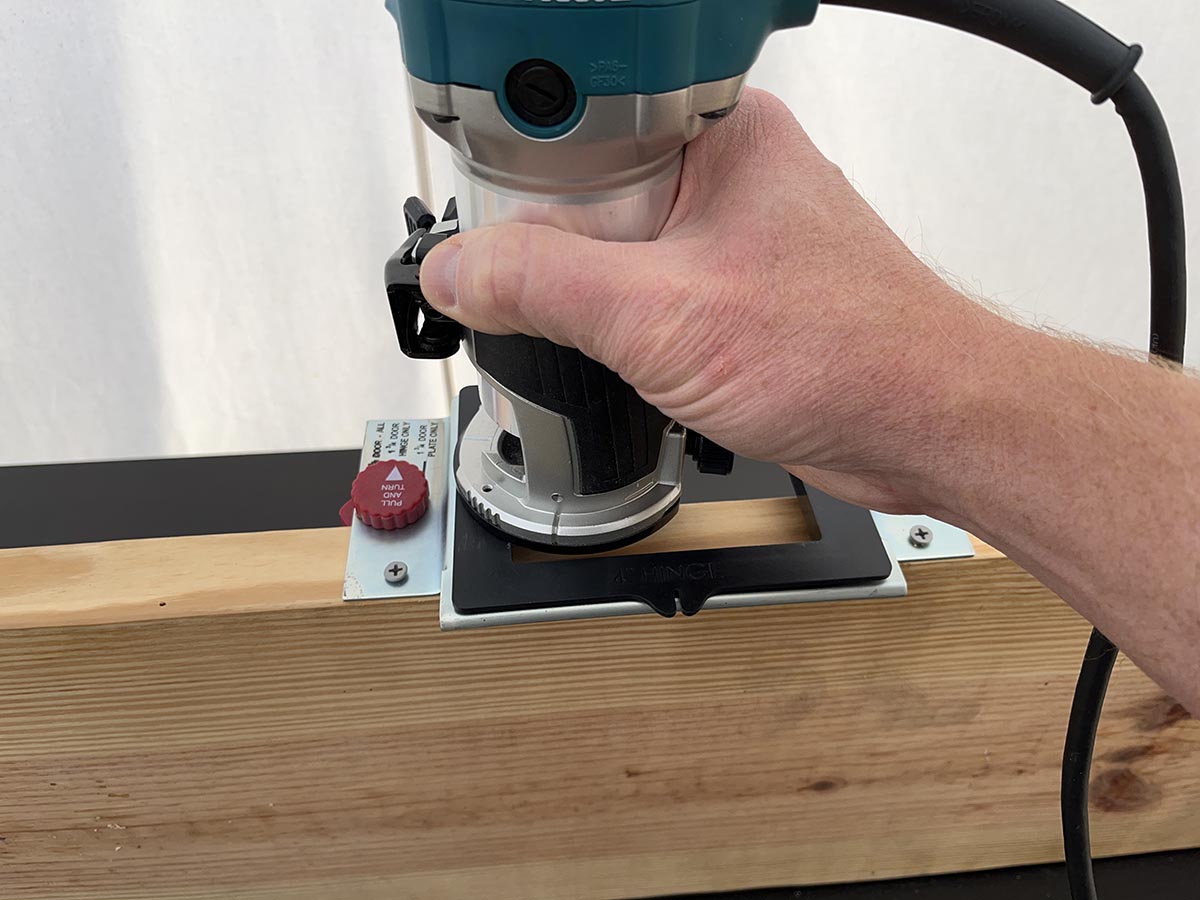
for Bob Vila
Best Overall
Milescraft HingeMate350 Door and Jamb Install Kit
What We Like
- Complete door installation template kit
- Includes router bit, self-centering drill bit, corner chisel
- Compatible with common door thicknesses
- Durable and easy to use
What We Don’t Like
- Lots of extra parts to keep track of
Specs
- Hinge templates: 2½ inch, 3 inch, 3½ inch, 4 inch, and 4½ inch
- Door thicknesses: 1⅜ inch, 1¾ inch
- Secures with: Cam clamp
Our Ratings: Ease of Use 5/5; Durability 5/5; Value 5/5
Aside from hinges, door hardware also includes door knobs, strike plates, and latch hardware. For complete installation, the Milescraft HingeMate350 not only includes five different size hinge routering guides, but it also comes with templates for latch and strike plate installation. The kit features a steel frame for the drop-in templates that aligns perfectly with an adjustable cam system. This kit works with doors 1⅜ inches or 1¾ inches thick.
After a quick survey of the house where we tested these jigs, we noted a mix of original and newer doors of different thicknesses, both interior and exterior. Had the project required us to install new hardware on every door, they all would have been compatible with the HingeMate350. Instead, we set up the template on the 2×12 board we used for the routering test, which measured a standard 1¾ inches thick. Setup was a simple matter of choosing the correct template for the hinge, orienting it in the steel frame according to our preference for square or rounded corners, and securing it with two screws. The template held fast while the router bit made clean accurate cuts, and we achieved a perfect fit every time.
The kit included two additional accessories to make the job even easier. The self-centering drill bit for predrilling screw holes ensured that we had the perfect screw placement and that the screws snugged down flush with the hinge surface. Also, for square-corner hinges, the included corner chisel made it easy to square up the routed corners for a perfect fit. The only downside we could find was that there are so many loose parts to store with the kit, unlike the other two we tested that were adjustable one-piece templates.
Get the Milescraft door hinge jig at Lowe’s, The Home Depot, Acme Tools, or Woodcraft.
More Door Hinge Jigs Worth Your Money
Each of the jigs we tested performed well, and some may be better than our top choice in certain circumstances. The Ryobi jig seemed less durable, but it features a much simpler design with fewer parts to store. The Porter-Cable 59370 template worked with a wider range of hinge sizes and door thicknesses. We identified other good options too, including 3-hinge setups that could make quick work of multiple door installations, as well as jigs for cabinet hinges that are concealed.
- Ryobi A99HT3 Door Hinge Template, available at Amazon or The Home Depot.
- Porter-Cable 59370 Door Hinge Template, available at Amazon, Ace Hardware, or Rockler.
- Milescraft 1229 Hinge Jig Plus, available at Amazon, The Home Depot, or Ace Hardware.
- Porter-Cable 59381 Door Hinge Template Kit, available at Amazon, Acme Tools, or ToolUp.
- Trend AnyDoor Butt Hinge Template, available at Amazon, Acme Tools, or Woodcraft.
- Kreg KHI-Hinge Concealed Hinge Jig, available at Amazon, Lowe’s, or The Home Depot.
- Milescraft 1342 Euro Hinge Jig, available at Amazon, The Home Depot, or Woodcraft.
How We Tested the Best Door Hinge Jigs
| Testing Stats | |
|---|---|
| Products tested | 3 |
| Time spent testing | 6 hours |
| Tests performed | 4 |
| Price range | $30 to $40 |
When it comes to choosing a jig for mortising door hinges, durability and ease of use are equally important. We tested jigs from Milescraft, Ryobi, and Porter-Cable by mounting them on the edges of 2×12 lumber, simulating the edge of a door measuring 1¾ inches thick. We also used the face of a 2×4 board to simulate a door jamb. We adjusted to match several different test hinges of four different sizes, routed the mortise for each hinge, and then inserted the hardware to check for accuracy. Throughout the process, we noted our observations regarding ease of use and perceived durability. We considered our experience as well as the practical uses of each product, given the range of hinge sizes and door thicknesses they could be used with. After testing, we scored the jigs on a rubric before naming our top choice.
| Ease of Use | Durability | Value | |
| Milescraft HingeMate350 Door and Jamb Install Kit | 5 | 5 | 5 |
| Ryobi A99HT3 Door Hinge Template | 5 | 4 | 5 |
| Porter-Cable 59370 Door Hinge Template | 4.5 | 4 | 5 |
What to Consider When Choosing the Best Door Hinge Jig
Hinges for full-size exterior and interior doors come in a range of sizes, and the doors themselves can be different thicknesses. The best door jigs for hinges accommodate these variations and make it easy to position the hinges correctly. Hinges that are correctly installed and properly lubricated make a squeaky door much less likely.
Material and Build Quality
Most door hinge router jigs are made from either injection-molded plastic or glass-reinforced plastic—also known as glass-reinforced nylon or fiberglass. Plastic is cheaper to produce, while fiberglass is tougher. Both materials would easily be damaged by either a router cutter (used with full-size door jigs) or a Forstner bit (used with cabinet jigs). However, the cutting edge should never come into direct contact with the jig, so damage should never be a problem. The special router bits used for template cutting have a bearing guide that follows the jig contour so that they only cut the wood.
Some of these jigs are made of aluminum or steel, which have the durability to withstand years of jobsite use.
Attaching Mechanism
Hinge jigs attach in two different ways. Some have a single clamp built in, which makes for fast work, though it’s important to make sure the jig is absolutely level. Others use locating pins that are positioned to match the door thickness and are then screwed or pinned in place. These are a bit more time-consuming, but arguably more secure.
Adjustability
The amount of adjustability provided by the best door hinge jigs depends very much on the type. Very basic cabinet hinge jigs are simply used to mark hole positions, and any adjustment is manual. More advanced models have rotating cams that give different spacings from the edge of the door. These jigs are usually one size to suit the hinge being used—either 35 millimeters (mm) or 26mm—though some can accommodate both.
Most full-size door hinge jigs can accommodate different-size hinges, though it’s important to check the range available. They have either a sliding mechanism or different-size templates that drop in.
As mentioned above, most jigs also have clamps or spacing pins to cope with various door thicknesses. With such variety in door measurements, it is essential to check this measurement as well. Door height is irrelevant as jigs can be positioned wherever required.
Additional Features and Accessories
A router bit is required to cut the hinge recess, and door hinge jigs for routers usually come with one included. The shank size will be either ¼ inch or ½ inch. Neither is better than the other, but the size will determine the kind of router used. Some ½-inch routers include a ¼-inch collet as an option, whereas ¼-inch routers cannot use ½-inch bits.
This type of door hinge jig creates a round-cornered cutaway in the door edge, and suitable round-cornered hinges are widely available. However, door hinges were traditionally square, and when refitting a door to an existing frame, it will often be necessary to cut away the rounded area. This can be done with an ordinary woodworking chisel, but corner chisels specifically for the purpose are available.
When hanging doors, be sure to prevent the handle from damaging the wall. Our article on choosing the best door stopper may prove useful.
Cabinet Door Hinge Jigs
Properly installed hinges reduce the need to adjust cabinet hinges, and the right jig can help. Cabinet door hinge jigs differ from those used to install walk-through doors, and we included two excellent examples in this guide, the Kreg KHI-Hinge Concealed Hinge drilling jig and the Milescraft 1342 Euro Hinge Jig. Cabinet hinges tend to be more uniform (see our article on The Best Soft Close Cabinet Hinges), so a single cabinet hinge jig tool can accommodate an entire kitchen remodel. Most cabinets these days are made with concealed hinges that attach to the backside of the door and require precise positioning to function correctly. The hidden hinge jig makes it much easier than freehand drilling.
Cabinet hinge jigs are held to the inside of the door with woodworking clamps. Ratcheting types are convenient because they are easy to use one-handed. Two clamps should be employed (one on either side of the cutter guide) to ensure that the jig can’t twist. Both of the cabinet hinge jigs we recommend include the Forstner bit required to drill the flat-bottomed hole for the main body of the hinge. Some also include a smaller drill bit to predrill holes for the retaining screws.
How to DIY Your Own Door Hinge Jig
Buying a door jig is the easy option, but with care, it is possible to make one. In fact, for cabinet doors, a jig isn’t strictly necessary. Measuring and marking accurately, holding the drill vertically, judging the depth of a hole are all that’s needed, and then a Forstner bit of the appropriate diameter to match the hinge will finish the job. Drill press owners will find the task easier, but a handheld drill and a steady hand can get the job done.
Making a jig for full-size doors should be well within the skill set of competent DIYers. An L-shaped frame with the appropriate cutout for the hinge position is all that’s really needed. We recommend using plywood or hardwood because composite board can be fragile. The DIY jig only has two parts that could either be joined by creating a slot in one with a router and attaching the other to it or by simply screwing the two together. Several easy-to-follow plans are available online.
FAQs
The guide above will prove useful in finding the right jig for full-size interior and exterior doors as well as cabinet doors. Those who want more info or clarification about these tools may well find it below in answers to some common questions about door hinge jigs.
Door hinges were traditionally cut with a wood mallet and chisel. Today, a router and jig combination makes the job quicker and easier. Cabinet door hinges are cut with a Forstner drill bit.
How the hinge jig is set up will depend on the type of jig. Some door jigs clamp to the side of the door, while others use locating pins and screws. Cabinet jigs usually need to be held in place using ordinary woodworking clamps, which will not be included. To ensure accuracy, it is important to follow the instructions that come with the jig.
A heavy door (often called a solid core door) should have a minimum of three hinges to spread the load and prevent it from dropping. In extreme cases, such as large oak external doors, four hinges may be necessary.
Both ¼-inch and ½-inch routers can be used for door hinges. One of our top picks, the Porter-Cable 59370 door hinge jig, uses a ¼-inch bit. Bear in mind that ½-inch routers often have ¼-inch collets and can therefore accept the smaller bit; however, ¼-inch routers cannot accept ½-inch bits.
Meet the Tester
Mark Wolfe is a writer, product tester and serial DIYer who lives in an older home. When he isn’t writing, he spends his time upgrading, repairing, and replacing anything and everything in his home, yard, and garden. He tests and writes reviews about hand and power tools, lawn care and home repair products, and outdoor living goods.
Additional research provided by Bob Beacham.
